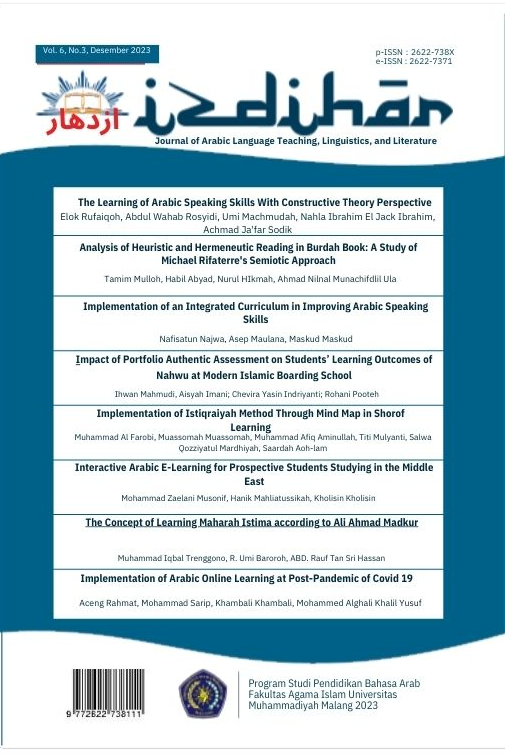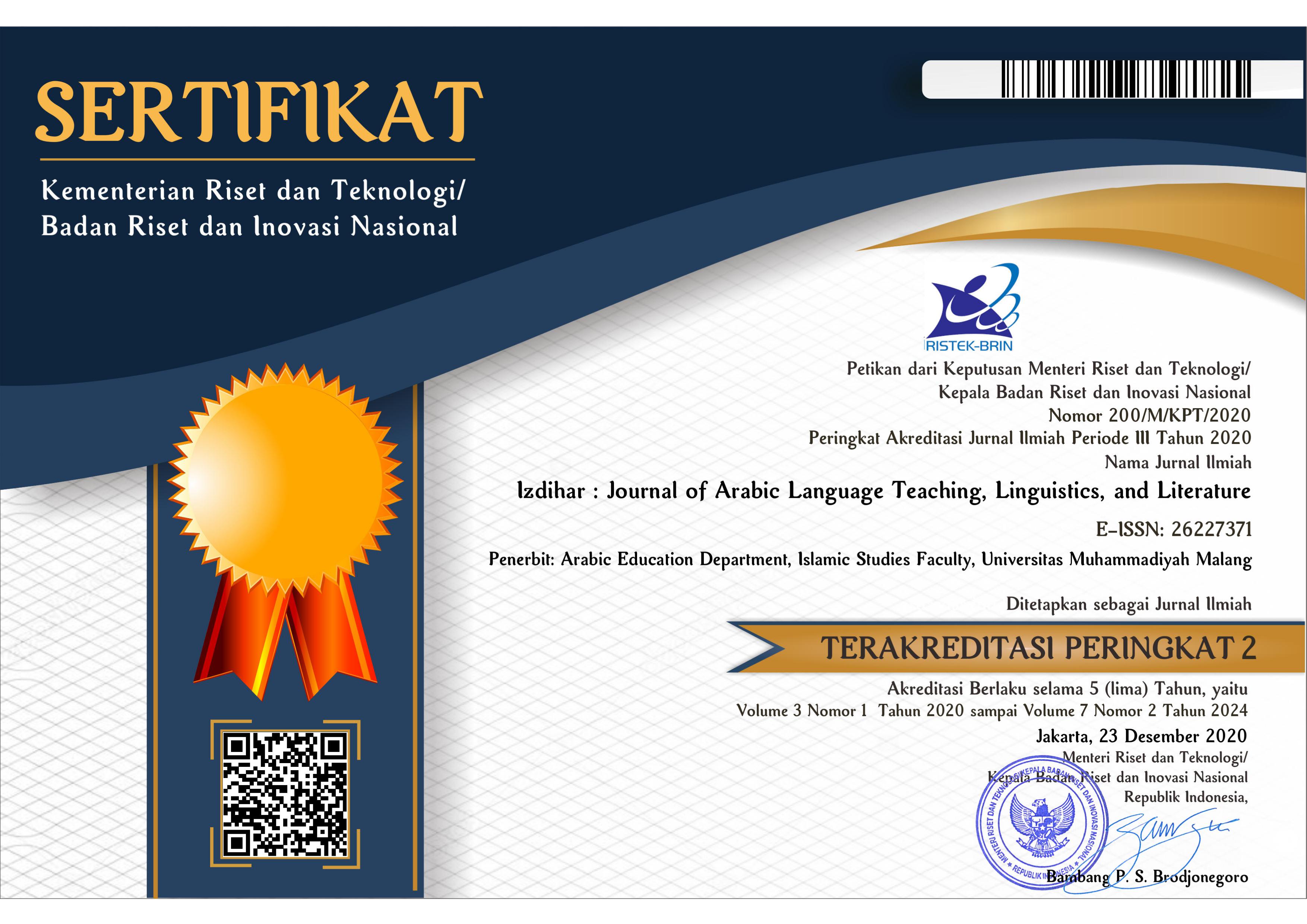Interactive Arabic E-Learning for Prospective Students Studying in the Middle East
DOI:
https://doi.org/10.22219/jiz.v6i3.28852Keywords:
Arabic E-learning, Needs Analysis, Middle East, Prospective StudentsAbstract
This research aimed to investigate the indicators in the analysis of needs for the development of Arabic language e-learning. The research was important as it served as the foundation for aspects that would be developed in the subsequent Research and Development phases. The research employed a descriptive research method with a quantitative approach. Data was collected through observation techniques, survey questionnaires, and literature review. The analysis results were aimed at determining the percentage values of each indicator and categorizing them based on these percentages. The findings of the needs analysis research indicated that there were six aspects that needed to be developed in the Markaz Arabiyah e-learning, namely usage guidelines for E-learning, self-learning materials, practice exercises, university selection exam simulations, information about universities in the Middle East, and discussion access.
Downloads
References
Al-Fadhli, S. (2008). Students’ Perceptions of E-learning in Arab Society: Kuwait University as a case study. E-Learning, 5(4), 418–428. https://doi.org/10.2304/elea.2008.5.4.418
Aldrup, K., Klusmann, U., Lüdtke, O., Göllner, R., & Trautwein, U. (2018). Student Misbehavior and Teacher Well-Being: Testing The Mediating Role of The Teacher-Student Relationship. Learning and Instruction, 58, 126–136. https://doi.org/https://doi.org/10.1016/j.learninstruc.2018.05.006
Aldulaimi, S. H., Abdeldayem, M. M., Keir, M. Y. A., & Al-Sanjary, O. I. (2021). E-Learning in Higher Education and Covid-19 Outbreak: Challenges and Opportunities. Psychology and Education Journal, 58(2), 38–43. https://doi.org/10.17762/pae.v58i2.1054
Alenezi, A. (2020). The role of e-learning materials in enhancing teaching and learning behaviors. International Journal of Information and Education Technology, 10(1), 48–56. https://doi.org/10.18178/ijiet.2020.10.1.1338
Aliyah, S. A., & Hidayanti, P. N. Y. (2022). Pembelajaran Bahasa Arab dengan Menggunakan E-Learning Berbasis Moodle. Aphorisme: Journal of Arabic Language, Literature, and Education, 3(1), 80–95. https://doi.org/10.37680/aphorisme.v3i1.1447
Arikunto, S. (2006). Prosedur Penelitian Suatu Pendekatan Praktik. PT Rineka Cipta.
Aysha Asra, S., & Kariapper, R. (2022). Modern Trends of E-Learning During Covid-19 Pandemic. International Journal of Engineering Applied Sciences and Technology, 7(8), 1–6. https://doi.org/10.33564/ijeast.2022.v07i08.001
Elawadi, E. M. S. S., Halim, Z. A., Al-Sammarraie, N. A., El-Ebiary, Y. A., & Pandey, B. (2019). The impact of e-learning in teaching Arabic language for non-native speakers. International Journal of Recent Technology and Engineering, 8(2 Special Issue 3), 1159–1162. https://doi.org/10.35940/ijrte.B1214.0782S319
Endrekson, R. (2022). Analisis Tingkat Kesehatan Unit Simpan Pinjam Pada Primer Koperasi Kartika Dwipangga Karang Endah. Management Studies and Entrepreneurship Journal (MSEJ), 3(1), 88–104. https://yrpipku.com/journal/index.php/msej/article/view/341
Fitriani, S. N., Syarifah, S., & Susanto, A. (2020). Pembelajaran Bahasa Arab Interaktif melalui Media E-Learning Madrasah di MTsN 1 Kota Malang. Tarbiyatuna: Jurnal Pendidikan Ilmiah, 5(2), 159–182. https://doi.org/10.55187/tarjpi.v5i2.4206
Ghani, K. A., Noh, A. S., Yusoff, N. M. R. N., & Hussein, N. H. (2021). Developing Readability Computational Formula for Arabic Reading Materials Among Non-native Students in Malaysia. Lecture Notes in Networks and Systems, 194 LNNS(March), 2041–2057. https://doi.org/10.1007/978-3-030-69221-6_147
Hannah, N., Qodim, H., Sururie, R. W., & Rahim, R. (2019). Flash Multimedia Application: An e-Learning Arabic Language for Mastering Fluency in Reading the Qur’an. 2019 7th International Conference on Cyber and IT Service Management, CITSM 2019, 16–19. https://doi.org/10.1109/CITSM47753.2019.8965412
Hasaniyah, N., Hula, I. R. N., Arif, M., Bahri, R. B. H., Miolo, M. I., Sarif, S., & Mariana, A. (2023). Development of Arabic Speaking Teaching Materials based on Tourism Anthropology: A Validator’s Assessment. International Journal of Membrane Science and Technology, 10(2), 1130–1143. https://doi.org/10.15379/IJMST.VI.1342
Helaluddin, H. (2018). Analisis Kebutuhan dalam Redesain Silabus (RPS) Mata Kuliah Bahasa Indonesia di Perguruan Tinggi. Jurnal Gramatika: Jurnal Penelitian Pendidikan Bahasa Dan Sastra Indonesia, 4(1), 85–103. https://doi.org/https://doi.org/10.22202/jg.2018.v4i1.2464
Hennig, S., & Nazarkulova, A. (2019). Benefits and Challenges of eLearning in Central Asia. International Journal of Geoinformatics, 15(4), 43–51. https://journals.sfu.ca/ijg/index.php/journal/article/view/1377
Jaya, I. M. L. M. (2020). Metode Penelitian Kuantitatif dan Kualitatif: Teori, Penerapan, dan Riset Nyata. Anak Hebat Indonesia.
Kew, S. N., & Tasir, Z. (2022). Developing a Learning Analytics Intervention in E-learning to Enhance Students’ Learning Performance: A Case Study. In Education and Information Technologies (Vol. 27, Issue 5). Springer US. https://doi.org/10.1007/s10639-022-10904-0
Kun Dai Yating Hu, X. L., & Oladipo, O. (2023). Conducting Doctoral Research in China: An Exploration of International Students’ Motivation to Study at Chinese Universities. Higher Education Research & Development, 42(5), 1133–1149. https://doi.org/10.1080/07294360.2023.2197195
Markaz Arabiyah. (n.d.). Katalog Program Offline. Markazarabiyah. Id. Retrieved February 4, 2023, from https://markazarabiyah.id/p/6f92fc/
Maydiantoro, A. (2021). Model-Model Penelitian Pengembangan (Research and Development). Jurnal Pengembangan Profesi Pendidik Indonesia (JPPPI). http://repository.lppm.unila.ac.id/43959/1/ARTICLE JPPPI.pdf
Mutmainnah, N. (2019). Pengembangan E-Learning Berbasis Aplikasi Moodle Sebagai Media Pembelajaran Bahasa Arab Untuk Siswa Kelas VIII MTsN 6 Bantul. Tesis. UIN Sunan Kalijaga Yogyakarta.
Priadana, M. S., & Sunarsi, D. (2021). Metode Penelitian Kuantitatif (Priadana,). Pascal Books.
Prosen, M., Karnjuš, I., & Ličen, S. (2022). Evaluation of E-Learning Experience among Health and Allied Health Professions Students during the COVID-19 Pandemic in Slovenia: An Instrument Development and Validation Study. International Journal of Environmental Research and Public Health, 19(8). https://doi.org/10.3390/ijerph19084777
Rafiee, M., & Abbasian-Naghneh, S. (2021). E-learning: development of a model to assess the acceptance and readiness of technology among language learners. Computer Assisted Language Learning, 34(5–6), 730–750. https://doi.org/10.1080/09588221.2019.1640255
Razeeth, M. S. S., Kariapper, R., Pirapuraj, P., Nafrees, A. C. M., Rishan, U. M., & Nusrath Ali, S. (2019). E-learning at home vs traditional learning among higher education students: a survey based analysis. Proceedings of 9th International Symposium, 213–221. http://192.248.66.13/bitstream/123456789/3909/1/25.pdf
Ritonga, A. W., Zulfida, S., Ritonga, M., Ardinal, E., & Susanti, D. (2021). The Use of E-learning as an Online-Based Arabic Learning Media for Students. Journal of Physics: Conference Series, 1933(1). https://doi.org/10.1088/1742-6596/1933/1/012127
Ruwaida, R. (2019). Pengembangan E-Learning Mata Pelajaran Bahasa Arab Berbasis Aplikasi Moodle Untuk Siswa Kelas X MA Mu’alimmat Nahdlatul Wathan Pancor Lombok Timur NTB. Jurnal Penelitian Tarbawi: Pendidikan Islam Dan Isu-Isu Sosial, 3(2), 1–22. https://doi.org/10.37216/tarbawi.v3i2.154
Salim, K., & Jardani, A. (2020). E-Learning in Higher Education; Challenges and Opportunities. International Journal of Innovation, Creativity and Change, 14(11), 2020. www.ijicc.net
Sari, D. P. (2017). Pengembangan Bahan Ajar Bahasa Arab Melalui Aplikasi E-Learning Berbasis Web Dengan Menggunakan A-Tutor Untuk Siswa Kelas X MAN Kota Batu. Universitas Negeri Malang.
Serin, H. (2022). Challenges and Opportunities of E-Learning in Secondary Schools in Iraq. International Journal of Social Sciences & Educational Studies, 9(3), 305–318. https://doi.org/10.23918/ijsses.v9i3p305
Setiawan, U. U. (2020). Pengembangan E-Learning Berbasis Website Program Studi Pendidikan Bahasa Arab IAIN Manado. IAIN Manado.
Shaalan, T. A. K., & Al-Jubouri, F. S. H. (2022). The Effect of E-Learning on The Achievement of Female Students of The First Intermediate Grades in The Arabic Language Subject and The Development of Their Logical Thinking. Journal of Misan Researches, 17(34–4), 543–558. https://www.iasj.net/iasj/article/251542
Shahba, A. A., Alashban, Z., Sales, I., Sherif, A. Y., & Yusuf, O. (2022). Development and Evaluation of Interactive Flipped e-learning (iFEEL) for Pharmacy Students during the COVID-19 Pandemic. International Journal of Environmental Research and Public Health, 19(7), 1–9. https://doi.org/10.3390/ijerph19073902
Shofa, M. I., Redhana, I. W., & Juniartina, P. P. (2020). Analisis Kebutuhan Pengembangan Media Pembelajaran IPA berbasis Argument Mapping. Jurnal Pendidikan Dan Pembelajaran Sains Indonesia (JPPSI), 3(1), 31–40. https://ejournal.undiksha.ac.id/index.php/JPPSI/article/view/24620
Solimando, C. (2022). E-Learning and Arabic in the Age of Covid-19: Rethinking the Learning of Vocabulary. Altre Modernità, 27, 166–180. https://doi.org/10.54103/2035-7680/17884
Sugeng, B. (2022). Fundamental Metodologi Penelitian Kuantitatif (Eksplanatif). Deepublish.
Sugiyono. (2013). Metode Penelitian Kuantitatif Kualitatif dan R&D (Cet. Ke-13). Alfabeta.
Sukmanto, B. T. (2020). Persepsi Kebutuhan Karakter Kerja Industri Bagi Tenaga Kerja Bekerja Di Industri Manufaktur Kabupaten Cirebon. Skripsi. Pendidikan Teknik Elektro. Universitas Negeri Yogyakarta.
Syakur, A., Musonif, M. Z., & Rachmawaty. (2022). Taqwīmu Ta’līmi al-Lugati al-‘Arabiyyati ‘Alā asāsi at-Ta’līm al-’iliktrūnī Fī Barnāmiji I’dādi ad-Dirāsati Li Syarqi al-Ausaṭi. Proceeding International Conference of Students on Arabic Language., 54–63. https://prosiding.arab-um.com/index.php/semnasbama/article/view/1185
Tawafak, R. M., Romli, A., Malik, S. I., Shakir, M., & Al Farsi, G. (2019). A systematic review of personalized learning: Comparison between e-learning and learning by coursework program in Oman. International Journal of Emerging Technologies in Learning, 14(9), 93–104. https://doi.org/10.3991/IJET.V14I09.10421
Wahyuningsih, E. (2022). Pengembangan Media Pembelajaran Menggunakan E-Learning Berbasis Moodle Dalam Pembelajaran Bahasa Arab Kelas X di MA Plus Manba’ul Adhim Jawa Timur [UIN SUNAN KALIJAGA YOGYAKARTA]. https://digilib.uin-suka.ac.id/id/eprint/54601/
Wijoyo, T. (2016). Pengembangan Media Pembelajaran E-Learning Berbasis Aplikasi Lectora Inspire untuk Keterampilan Membaca Bahasa Arab Siswa MTs Kelas VIII. Lisanul Arab: Journal of Arabic Learning and Teaching, 5(1). https://doi.org/10.15294/la.v5i1
Williams, J. P. (2008). Nonparticipant Observation. In L. M. Given (Ed.), Sage Encyclopedia of Qualitative Research Methods (pp. 561–562). Sage.
Zubaidah, Kardena, A., Shalihah, S., Hodijah, O., Afrida, Y., & Safitri, L. (2021). Web-based e-learning Application for learning Arabic language. Journal of Physics: Conference Series, 1779(1). https://doi.org/10.1088/1742-6596/1779/1/012011
Downloads
Published
How to Cite
Issue
Section
License
Copyright (c) 2024 Mohammad Zaelani Musonif, Hanik Mahliatussikah, Kholisin Kholisin

This work is licensed under a Creative Commons Attribution-ShareAlike 4.0 International License.
Copyright Notice
Authors who publish with this journal agree to the following terms:
- Authors retain copyright and grant the journal right of first publication with the work simultaneously licensed under a Creative Commons Attribution-ShareAlike 4.0 International License that allows others to share the work with an acknowledgment of the work's authorship and initial publication in this journal.
- Authors are able to enter into separate, additional contractual arrangements for the non-exclusive distribution of the journal's published version of the work (e.g., post it to an institutional repository or publish it in a book), with an acknowledgment of its initial publication in this journal.
- Authors are permitted and encouraged to post their work online (e.g., in institutional repositories or on their website) prior to and during the submission process, as it can lead to productive exchanges, as well as earlier and greater citation of published work (See The Effect of Open Access).
Copyright (c) 2019 Izdihar : Journal of Arabic Language Teaching, Linguistics, and Literature

This work is licensed under a Creative Commons Attribution-ShareAlike 4.0 International License.


















